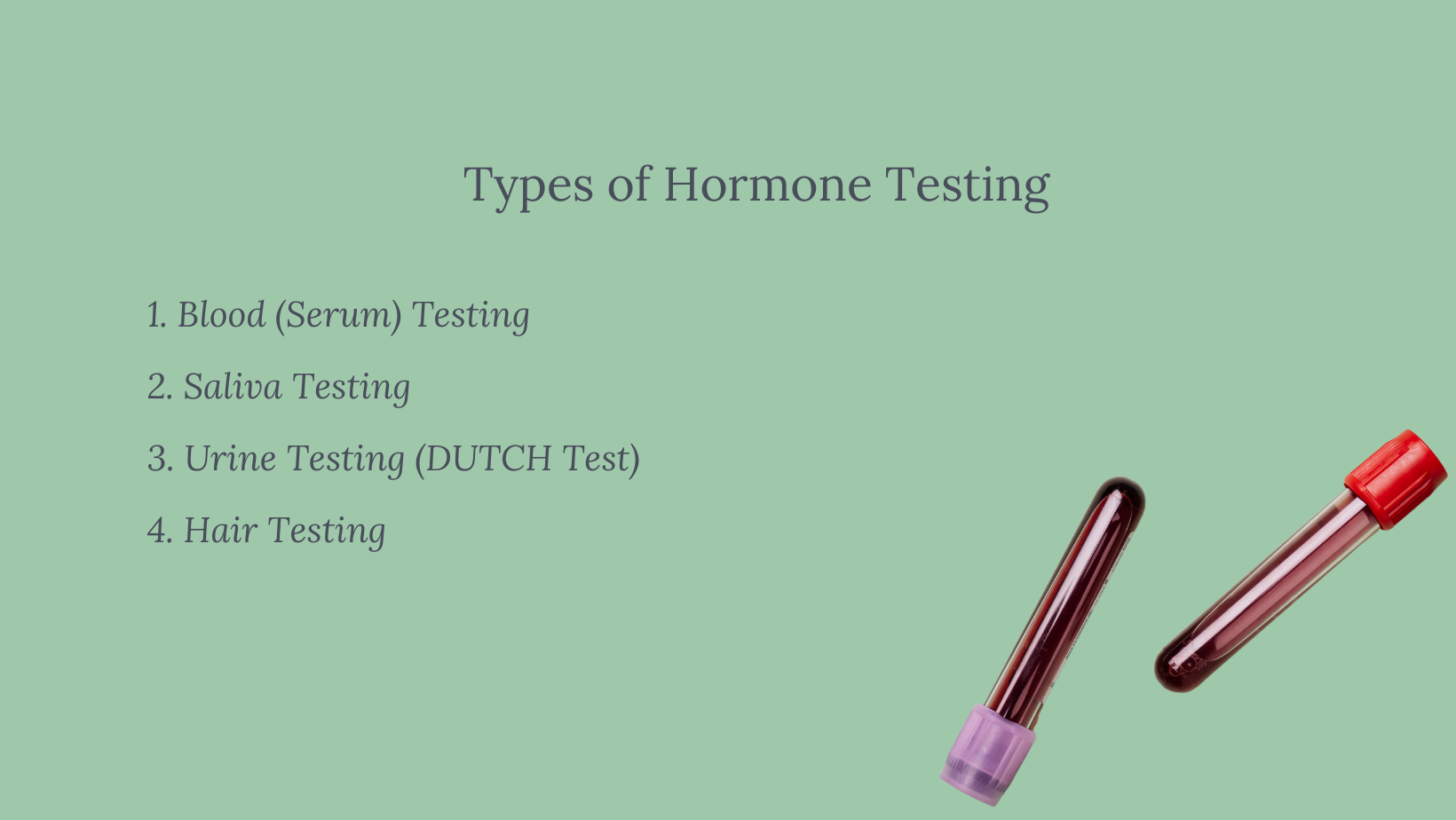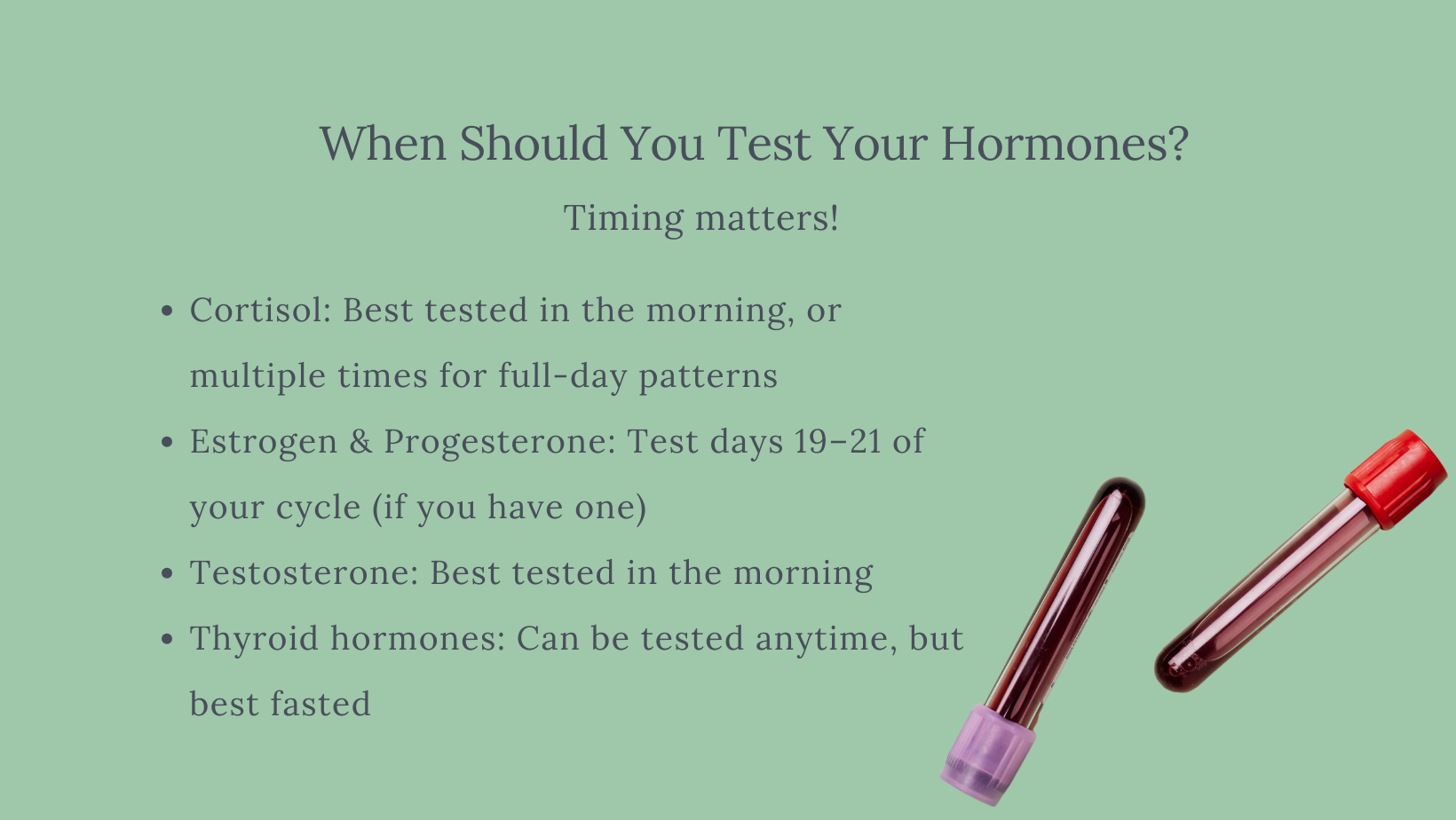Hormone Testing for Women: What You Need to Know

Hormones influence everything—your energy levels, mood, metabolism, menstrual cycle, sleep, and stress response. When they’re in sync, you feel great. But when they’re off? Fatigue, mood swings, irregular periods, unexplained weight gain, and even brain fog can take over.
If you’ve ever wondered whether your hormones might be behind your symptoms, testing could provide answers. But with so many options—blood, saliva, urine, and even hair—it’s easy to feel overwhelmed. Let’s break it down.
Why Consider Hormone Testing?
Hormones naturally fluctuate throughout life—especially during puberty, pregnancy, postpartum, perimenopause, and menopause. But imbalances can happen at any stage. Some common signs that your hormones may need testing include:
- Chronic fatigue, even after a good night’s sleep
- Anxiety, mood swings, or unexplained irritability
- Difficulty losing or gaining weight
- Irregular or painful periods
- Low libido or vaginal dryness
- Hair loss or excessive hair growth
- Sleep disturbances or feeling wired but tired
- Bloating, digestive discomfort, or persistent skin issues
If any of these sound familiar, testing can help uncover the root cause.
Types of Hormone Testing:

1. Blood (Serum) Testing
🔹 Best for: Total hormone levels (estrogen, progesterone, testosterone, thyroid hormones, insulin, prolactin)
🔹 Commonly used for: Diagnosing PCOS, thyroid imbalances, menopause, fertility issues, metabolic health
✅ Pros:
- Highly accurate and widely used in conventional medicine
- Reliable for diagnosing hormone-related conditions
- Standardized reference ranges available
❌ Cons:
- Invasive (requires a blood draw)
- Provides only a snapshot in time rather than showing daily fluctuations
- Measures both bound (inactive) and free (active) hormones, which may not reflect actual hormone activity
2. Saliva Testing
🔹 Best for: Measuring free (active) hormones, especially cortisol, estrogen, progesterone, and testosterone
🔹 Commonly used for: Stress and adrenal health, menstrual cycle tracking, perimenopause hormone shifts
✅ Pros:
- Non-invasive, can be done at home
- More accurate for measuring biologically active hormones (since 95–99% of hormones in blood are bound to carrier proteins)
- Ideal for tracking daily fluctuations of hormones like cortisol
❌ Cons:
- Results can be affected by diet, hydration, and oral health
- Not ideal for monitoring long-term hormone levels due to short-term variability
📌 Tip for better long-term monitoring: Collect multiple saliva samples over time—especially for hormones that fluctuate throughout the day (like cortisol) or month (like estrogen/progesterone in cycling women).
3. Urine Testing (DUTCH Test)
🔹 Best for: Comprehensive hormone metabolite assessment
🔹 Commonly used for: Adrenal health, estrogen detox pathways, functional medicine insights
✅ Pros:
- Measures hormone production and breakdown over 24 hours
- Offers insights into how your body detoxifies and eliminates hormones
❌ Cons:
- More expensive
- Requires multiple timed samples throughout the day
4. Hair Testing (Emerging Method for Long-Term Monitoring)
🔹 Best for: Long-term hormone trends, since hair provides a stable record over weeks to months
✅ Pros:
- Less impacted by short-term fluctuations
- Non-invasive and convenient
❌ Cons:
- Still experimental in some areas
- Not widely used or standardized

What Else Affects Hormone Test Results?
External factors can influence hormone levels and how accurately they’re measured:
- Stress: Can spike cortisol and suppress reproductive hormones
- Sleep: Poor quality sleep may impact cortisol, testosterone, and thyroid hormones
- Exercise: Intense workouts right before testing can affect hormone levels
- Fasting/Diet: Some tests require fasting, others don’t
- Medications & Supplements: Certain supplements (like biotin) can interfere with lab results, especially for thyroid testing
Best Tests for Long-Term Monitoring
If you're interested in tracking hormone health over time, some methods work better than others:
✅ Good options for long-term insights:
- Hair testing – more stable, less affected by daily variation
- Multiple saliva samples – useful for hormones with daily or monthly patterns
- Blood tests – especially for thyroid hormones and prolactin
🚫 Less ideal: Single-sample saliva or blood tests without context—they miss fluctuations and trends.
What’s the Difference?

💡 You might feel off even when your blood results are “normal.” That’s where functional testing can help identify what’s not working quite right.
The Future of Hormone Testing
Technology is evolving quickly—and hormone testing is going digital:
- Wearables and skin patches may soon allow continuous hormone tracking
- Home testing kits are becoming more advanced, with dried blood spot, saliva, and urine options
- AI-based tools could soon help track cycle changes, fertility windows, and stress responses more accurately
Final Thoughts
Hormone health isn’t just about perimenopause or menopause—it affects every stage of a woman’s life. Whether you're struggling with energy, mood, weight, or menstrual changes, hormone testing can offer clarity and next steps.
The key is choosing the right test, at the right time, in the right context.
👩⚕️ If you're looking for an easy way to get started, Strawberry Health offers convenient, at-home blood tests designed specifically for women. It’s a smart and supportive way to explore your hormone health—without needing to step foot in a clinic.